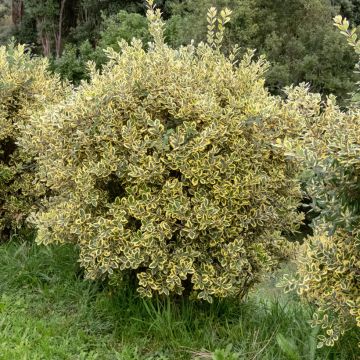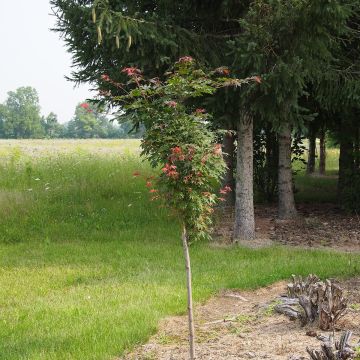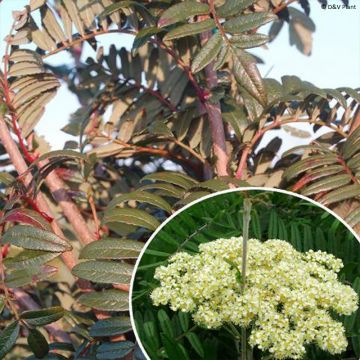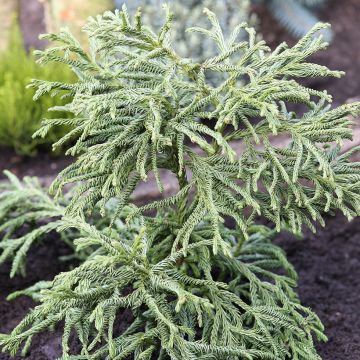

Acer x conspicuum Silver Cardinal - Maple
Acer x conspicuum Silver Cardinal - Maple
Acer x conspicuum Silver Cardinal
Snakebark Maple
Why not try an alternative variety in stock?
View all →This plant carries a 24 months recovery warranty
More information
We guarantee the quality of our plants for a full growing cycle, and will replace at our expense any plant that fails to recover under normal climatic and planting conditions.
Oversize package: home delivery by special carrier from €6.90 per order..
Express home delivery from €8.90.
Does this plant fit my garden?
Set up your Plantfit profile →
Description
The Acer x conspicuum 'Silver Cardinal' is an absolutely remarkable hybrid maple with a "snake skin" bark. It is a small tree with extremely decorative bark and foliage. This variety is characterised by a young red bark veined with white, red young shoots, and spring leaves variegated with pink and green. In autumn, they turn yellow with pink variegation. When leafless, its branches are pleasant to contemplate in winter. Its modest size and slow growth make this small tree a good candidate for small gardens, to be placed prominently.
The Acer x conspicuum 'Silver Cardinal' belongs, like all maples, to the Sapindaceae family (formerly Aceraceae). This hybrid is said to have originated from a seedling of the striped maple (Acer pensylvanicum) and was introduced by Windsor Great Park (GB) in 1985. Other authors classify it as an Acer x conspicuum. 'Silver Cardinal' is a deciduous tree with slow growth, reaching barely 5m in height and 2.5 to 3m in spread at the age of 20. It develops a fairly short trunk topped with a semi-spreading crown, less dense than that of the Acer davidii. The young branches are red, the young bark of the branches is red veined with white. The older branches and trunk, whose pattern resembles that of a snake skin in the process of shedding, are longitudinally striated with white. The deciduous foliage appears in spring and falls in autumn. The leaves, arranged oppositely on the branches, have 2 small lobes at their base and measure about 6 to 8 cm in length. When they bud burst, they are variously maculated and speckled with pink on a green background. They become greener in summer, while retaining some variegation here and there. Before falling in October, their colour is yellow with pink variegation. The red petiole that carries them matches well with the colour of the lamina in autumn. In June, a rather insignificant flowering gives way to winged fruits called samaras, measuring 3 to 5 cm in length.
The Acer x conspicuum 'Silver Cardinal' is a small tree that prefers non-burning sun or partial shade and non-limestone, not too dry soils. If your garden can provide these conditions that it appreciates, it will become the centrepiece. This variety will find its place in small gardens, highlighted in the centre of an ericaceous soil bed surrounded by simple-shaped perennials such as hostas, ferns, or Japanese grasses (Hakonechloa), for example, plants that will not overshadow its personality.
Plant habit
Flowering
Foliage
Botanical data
Acer
x conspicuum
Silver Cardinal
Sapindaceae
Snakebark Maple
Acer 'Silver Cardinal'
Cultivar or hybrid
Other Acer - Maple tree
View all →Planting and care
The Acer conspicuum 'Silver Cardinal' should be planted in spring or autumn in a fertile and well-drained soil, acidic to neutral, non-limestone, deep, in a gently sunny or preferably semi-shaded location. It prefers the soil to remain moist throughout the year, without being waterlogged. Once well-rooted, it can tolerate somewhat dry summers. Beware of strong winds. Keep the soil moist during the first two summers following planting. Mulching can be beneficial to maintain soil moisture. Pruning is necessary for young plants, and then every 3 years to balance the branches and maintain a harmonious habit, if necessary. Do not prune after December, as sap rises very early.
Planting period
Intended location
Care
This item has not been reviewed yet - be the first to leave a review about it.
Similar products
Haven't found what you were looking for?
Hardiness is the lowest winter temperature a plant can endure without suffering serious damage or even dying. However, hardiness is affected by location (a sheltered area, such as a patio), protection (winter cover) and soil type (hardiness is improved by well-drained soil).

Photo Sharing Terms & Conditions
In order to encourage gardeners to interact and share their experiences, Promesse de fleurs offers various media enabling content to be uploaded onto its Site - in particular via the ‘Photo sharing’ module.
The User agrees to refrain from:
- Posting any content that is illegal, prejudicial, insulting, racist, inciteful to hatred, revisionist, contrary to public decency, that infringes on privacy or on the privacy rights of third parties, in particular the publicity rights of persons and goods, intellectual property rights, or the right to privacy.
- Submitting content on behalf of a third party;
- Impersonate the identity of a third party and/or publish any personal information about a third party;
In general, the User undertakes to refrain from any unethical behaviour.
All Content (in particular text, comments, files, images, photos, videos, creative works, etc.), which may be subject to property or intellectual property rights, image or other private rights, shall remain the property of the User, subject to the limited rights granted by the terms of the licence granted by Promesse de fleurs as stated below. Users are at liberty to publish or not to publish such Content on the Site, notably via the ‘Photo Sharing’ facility, and accept that this Content shall be made public and freely accessible, notably on the Internet.
Users further acknowledge, undertake to have ,and guarantee that they hold all necessary rights and permissions to publish such material on the Site, in particular with regard to the legislation in force pertaining to any privacy, property, intellectual property, image, or contractual rights, or rights of any other nature. By publishing such Content on the Site, Users acknowledge accepting full liability as publishers of the Content within the meaning of the law, and grant Promesse de fleurs, free of charge, an inclusive, worldwide licence for the said Content for the entire duration of its publication, including all reproduction, representation, up/downloading, displaying, performing, transmission, and storage rights.
Users also grant permission for their name to be linked to the Content and accept that this link may not always be made available.
By engaging in posting material, Users consent to their Content becoming automatically accessible on the Internet, in particular on other sites and/or blogs and/or web pages of the Promesse de fleurs site, including in particular social pages and the Promesse de fleurs catalogue.
Users may secure the removal of entrusted content free of charge by issuing a simple request via our contact form.





























































